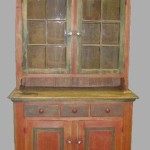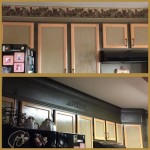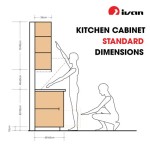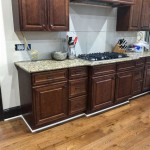Do You Paint The Inside Of Your Kitchen Cabinets Clean?
The question of whether to paint the inside of kitchen cabinets, and whether to prioritize cleanliness in the process, is a common consideration for homeowners undertaking kitchen renovations or simply seeking to refresh their existing space. While painting the interior of cabinets is not strictly necessary, it offers several aesthetic and functional benefits. The decision ultimately depends on individual preferences, budget, and the desired level of finish.
Painting the inside of kitchen cabinets can enhance the overall look and feel of the kitchen. Bare wood or dated finishes inside cabinets can detract from the aesthetic appeal of a newly renovated or updated kitchen. A fresh coat of paint can brighten the interior space, making it feel cleaner and more inviting. This is particularly beneficial for cabinets with glass doors, as the interior becomes more visible. The choice of paint color can also complement the exterior cabinet color or the overall kitchen décor. A light color, such as white or off-white, tends to maximize light reflection, making it easier to see the contents of the cabinet. Darker colors, on the other hand, can create a more dramatic or sophisticated look, but may require additional lighting.
Beyond aesthetics, painting the inside of kitchen cabinets can also improve their durability and hygiene. Unfinished wood is porous and can absorb moisture, grease, and odors, leading to staining and potential damage over time. Paint acts as a sealant, creating a barrier that protects the wood from these elements. This can extend the lifespan of the cabinets and make them easier to clean. A smooth, painted surface is less likely to harbor dirt and bacteria, making it a more hygienic environment for storing food and kitchenware. Specifically, using a satin or semi-gloss paint finish can make cleaning spills and stains much easier than cleaning raw wood.
The process of painting the inside of kitchen cabinets requires careful preparation and execution to achieve a professional and long-lasting result. Proper preparation is crucial for ensuring that the paint adheres properly and that the finish is smooth and even. This typically involves cleaning the interior surfaces thoroughly to remove any dirt, grease, or loose debris. Sanding the surfaces may also be necessary to create a slightly rough texture that will allow the paint to grip better. Any holes or imperfections should be filled with wood filler and sanded smooth. Finally, applying a primer is essential for sealing the wood and providing a uniform base for the paint.
The choice of paint is also important. Interior paints specifically formulated for cabinets are typically the best option. These paints are designed to be durable, washable, and resistant to chipping and scratching. Oil-based paints offer excellent durability and a smooth finish, but they can be more difficult to work with and require longer drying times. Latex paints are a more environmentally friendly option and are easier to clean up, but they may not be as durable as oil-based paints. Acrylic latex paints offer a good balance of durability, ease of use, and low VOC (volatile organic compounds) content. It is also recommended to use a paint with a mold and mildew resistant formula, especially in areas prone to moisture, such as under the sink.
Applying the paint in thin, even coats is crucial for achieving a professional-looking finish. Multiple thin coats are better than one thick coat, as they are less likely to run or drip. A good quality brush or roller can help to ensure a smooth and even application. It is important to allow each coat of paint to dry completely before applying the next one. Lightly sanding between coats can also help to create a smoother finish. Proper ventilation is essential when painting, especially when using oil-based paints. It is also important to protect the surrounding surfaces with drop cloths and painter's tape to prevent paint splatters.
Maintaining cleanliness during the painting process is important for several reasons. A clean work environment helps to prevent dust and debris from getting into the paint, which can result in a rough or uneven finish. Cleaning the surfaces thoroughly before painting ensures that the paint will adhere properly and that the finish will be durable. It is also important to clean up any spills or splatters immediately to prevent them from drying and becoming difficult to remove. Using clean brushes and rollers is also essential for achieving a professional-looking finish.
The decision to paint the inside of kitchen cabinets clean is a matter of personal preference, but it is important to consider the potential benefits. A fresh coat of paint can brighten the interior space, make it feel cleaner and more inviting, and protect the wood from moisture, grease, and odors. The process requires careful preparation, the right choice of paint, and meticulous application. By following these guidelines, homeowners can achieve a professional and long-lasting result that enhances the overall look and feel of their kitchen.
Key Point 1: Aesthetic Enhancement of Cabinet Interiors
Painting the interior of kitchen cabinets significantly contributes to the overall aesthetic appeal of the kitchen. Unfinished or aged interiors can detract from the visual harmony of the space, particularly in kitchens with updated or renovated exteriors. A fresh coat of paint, especially in a light color like white or off-white, can brighten the cabinet's interior, making it appear cleaner and more spacious. This is especially true for cabinets with glass doors, where the interior is readily visible. The choice of paint color should complement the exterior cabinet color and the overall kitchen decor. While lighter colors maximize light reflection, darker colors can create a more dramatic effect. However, darker interiors might require additional lighting to ensure visibility.
The aesthetic benefits extend beyond mere visual appeal. A painted interior can transform the way a homeowner interacts with their kitchen. Opening a cabinet to a bright, clean interior provides a sense of satisfaction and pride. It can also make organizing and locating items easier, as the enhanced visibility reduces the need to rummage through dimly lit spaces. Furthermore, a well-painted interior can increase the perceived value of the kitchen, a factor that is especially important for homeowners considering future resale.
Beyond the color choice, the finish of the paint also plays a crucial role in the aesthetic outcome. Satin and semi-gloss finishes are popular choices for cabinet interiors due to their smooth appearance and ease of cleaning. A glossy finish can further enhance light reflection, while a matte finish may offer a more subtle and understated look. The selection of the appropriate finish should consider both the desired aesthetic and the practical needs of the kitchen environment.
Key Point 2: Protection and Hygiene Improvement
Painting the inside of kitchen cabinets offers significant protection and hygiene benefits. Unfinished wood is porous and susceptible to absorbing moisture, grease, and odors, which can lead to staining, warping, and the growth of mold and mildew. Paint acts as a sealant, creating a barrier that prevents these substances from penetrating the wood. This protection extends the lifespan of the cabinets and reduces the frequency of cleaning and maintenance.
The hygienic advantages of a painted interior are particularly relevant in the kitchen environment, where food storage and preparation take place. A smooth, painted surface is less likely to harbor dirt, bacteria, and food particles compared to raw wood. This makes it easier to clean and sanitize the interior, reducing the risk of contamination. Choosing a paint with antimicrobial properties can further enhance the hygienic benefits.
The choice of paint finish also influences the level of protection and hygiene. Satin and semi-gloss finishes are easier to wipe clean than matte finishes, making them ideal for cabinet interiors. These finishes create a smooth, non-porous surface that resists staining and the accumulation of dirt and debris. When selecting a paint, it is important to consider its resistance to moisture, grease, and chemicals, as well as its ability to withstand frequent cleaning.
Key Point 3: Proper Preparation and Execution for Optimal Results
Achieving a professional and long-lasting painted finish inside kitchen cabinets requires meticulous preparation and execution. The success of the project hinges on the quality of the preparation, which includes thoroughly cleaning the interior surfaces to remove any dirt, grease, and debris. This may involve using a degreasing cleaner to remove stubborn stains. Following the cleaning process, sanding the surfaces is essential to create a slightly rough texture that promotes paint adhesion.
Any imperfections, such as holes or cracks, should be filled with wood filler and sanded smooth. This ensures a uniform surface for painting and prevents the imperfections from being visible through the final finish. Applying a primer is a crucial step in the preparation process. Primer seals the wood, prevents the paint from being absorbed, and provides a uniform base for the paint. It also enhances the adhesion of the paint and helps to prevent staining.
The application of the paint should be done in thin, even coats, using a high-quality brush or roller. Multiple thin coats are preferable to a single thick coat, as they are less likely to run or drip. Each coat should be allowed to dry completely before applying the next one. Lightly sanding between coats can further improve the smoothness of the finish. Proper ventilation is essential during the painting process, especially when using oil-based paints. Protecting the surrounding surfaces with drop cloths and painter's tape is also necessary to prevent paint splatters. Cleaning up any spills or splatters immediately will prevent them from drying and becoming difficult to remove, contributing to a cleaner and more professional final result.

How To Paint Inside Kitchen Cabinets In 7 Steps Benjamin Moore

How To Paint Kitchen Cabinets A Step By Guide Confessions Of Serial Do It Yourselfer

How To Paint Inside Kitchen Cabinets In 7 Steps Benjamin Moore

How To Paint Unfinished Cabinets Houseful Of Handmade

Should I Paint The Inside Underside Of My Kitchen Cabinets

How To Clean Prep Wood Kitchen Cabinets Before Painting Do Dodson Designs

How To Paint Kitchen Cabinets A Step By Guide Confessions Of Serial Do It Yourselfer

How To Paint Kitchen Cabinets Follow These Easy Tips

How To Paint Kitchen Cabinets A Step By Guide Confessions Of Serial Do It Yourselfer

How To Paint Kitchen Cabinets In 7 Simple Steps
Related Posts








